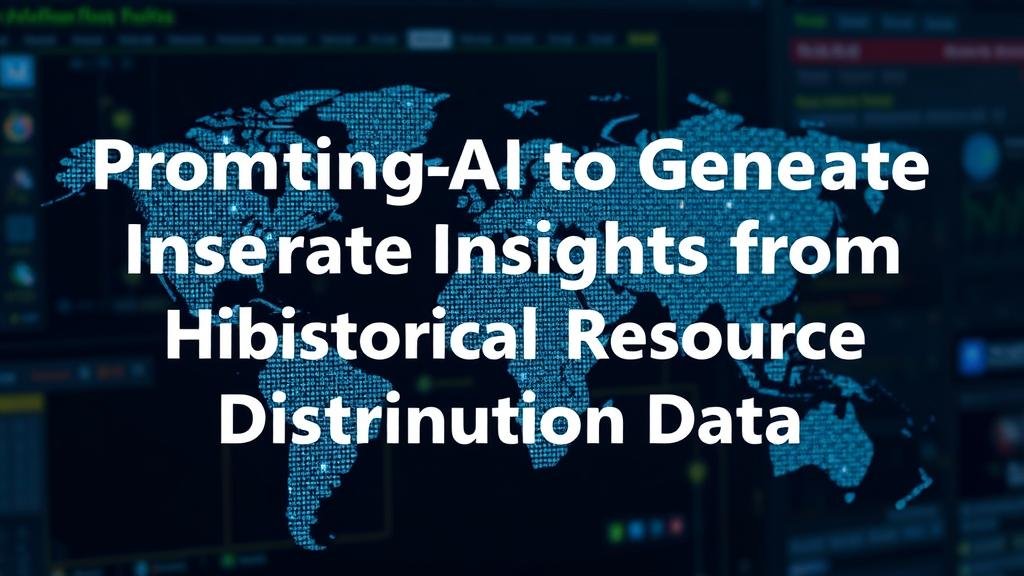Prompting AI to Generate Insights from Historical Resource Distribution Data
Prompting AI to Generate Insights from Historical Resource Distribution Data
The advent of artificial intelligence (AI) has enabled researchers to explore vast datasets in ways that were previously unimaginable. One significant area of study is the examination of historical resource distribution data, revealing insights about economic trends, sociocultural dynamics, and environmental changes over time. This article discusses methodologies for utilizing AI, particularly natural language processing (NLP) and machine learning (ML), to extract meaningful insights from historical resource distribution data.
The Importance of Historical Resource Distribution Data
Historical resource distribution data encompasses a wide array of information, including the availability of natural resources, economic commodities, and agricultural outputs across different regions and time periods. Understanding these distributions aids in discerning patterns that influence human development, societal structures, and environmental sustainability.
- Natural Resource Availability: Examining how natural resources such as coal, oil, or water were distributed during the Industrial Revolution can elucidate the rise of industrial cities.
- Agricultural Outputs: Analyzing crop yields and livestock distribution in ancient civilizations provides insights into the economic systems that supported them.
AI Technologies for Analyzing Historical Data
AI technologies, particularly ML and NLP, can efficiently manage and analyze extensive datasets. Here are several approaches that have proven effective:
- Natural Language Processing: NLP can be used to mine text-based historical records, such as government documents or trade logs, categorizing and summarizing information regarding resource distribution.
- Machine Learning Algorithms: Supervised and unsupervised learning algorithms can identify patterns and trends in numerical datasets, such as regional resource distribution over time.
Case Studies of AI in Historical Analysis
Several case studies illustrate the successful application of AI in analyzing historical resource distribution data. One notable example is the use of AI to study the distribution of mineral resources in South Africa during the late 19th century.
Researchers from the University of the Witwatersrand utilized machine learning techniques to analyze data derived from mining reports and local economic records. found a correlation between mineral discovery dates and the economic growth patterns in Johannesburg, effectively showcasing how AI can reveal contextual relationships in historical data.
Challenges in Data Quality
Despite the promising applications of AI, challenges related to data quality and integrity must be addressed. Historical records may be incomplete, inconsistent, or biased. For example, early records of resource distribution often come from colonial perspectives, which may misrepresent indigenous resource utilization.
In the case of agricultural data, 19th-century crop yield reports may lack standardization, making comparisons across regions and time periods challenging. To mitigate these issues, researchers must:
- Establish standardized data formats for historical records.
- Use preprocessing techniques to clean and normalize datasets.
Ethical Considerations in AI Applications
When applying AI to historical data, ethical considerations emerge, particularly related to data privacy, representation, and bias. Researchers should ensure that the insights generated do not inadvertently perpetuate historical injustices or reinforce stereotypes about marginalized communities.
Future Directions
The future of utilizing AI for analyzing historical resource distribution data is promising. Enhancements in data accessibility and advances in AI technologies such as deep learning will likely yield new insights. Researchers are encouraged to adopt interdisciplinary approaches, combining history, economics, and computer science to fully leverage AI’s potential.
One area ripe for exploration is the integration of geospatial data with historical resource distribution analysis. Geographic Information Systems (GIS) combined with AI can visualize and analyze trends more effectively, providing a clearer historical context.
Conclusion
To wrap up, prompting AI to generate insights from historical resource distribution data presents an exciting frontier for research across various disciplines. By utilizing AI’s analytical capabilities, researchers can uncover patterns that contribute to a deeper understanding of historical contexts. Addressing data quality and ethical implications will be pivotal as the field evolves, ensuring that AI serves as a tool for enlightenment rather than a means to reproduce historical biases.


